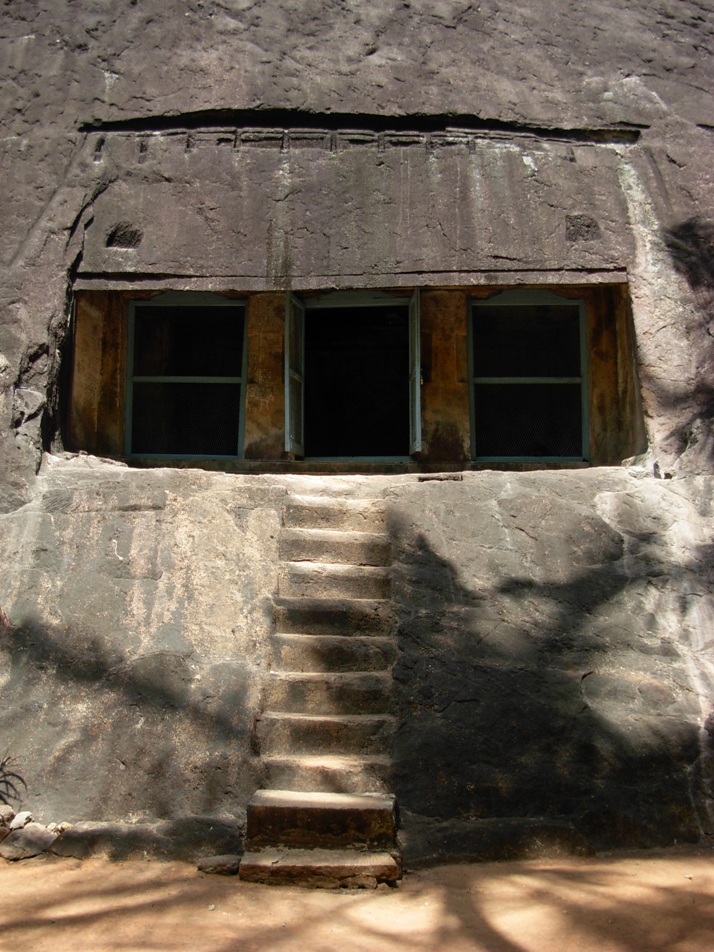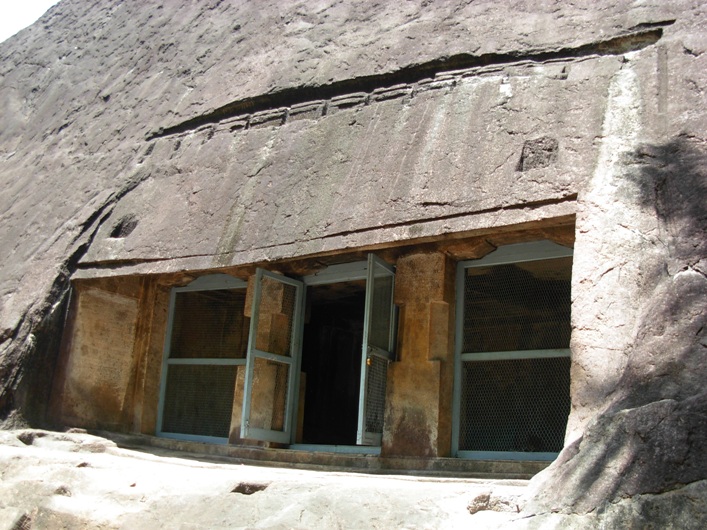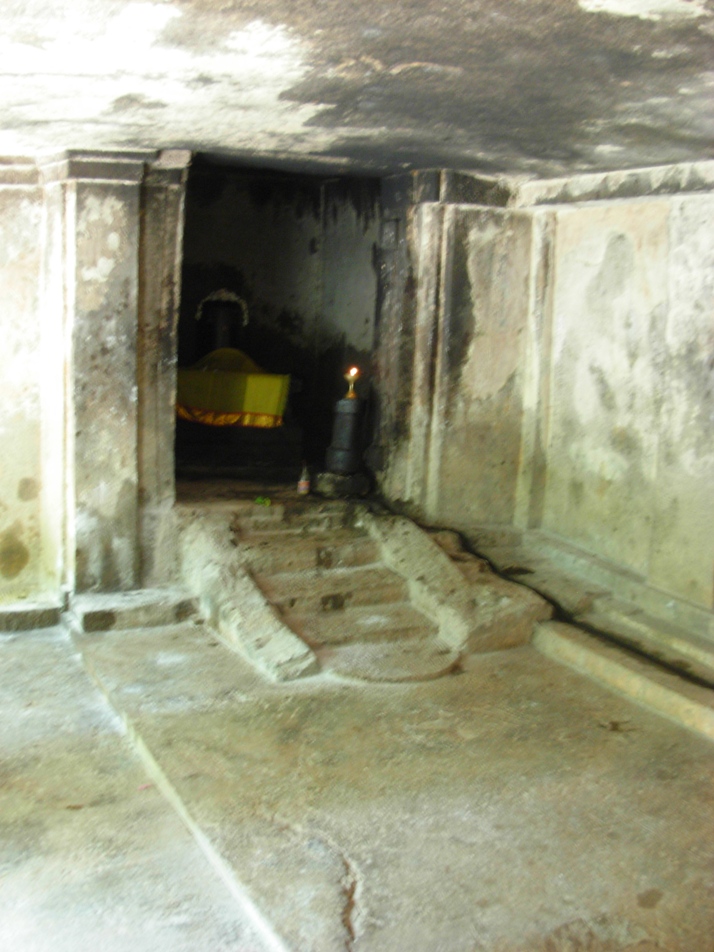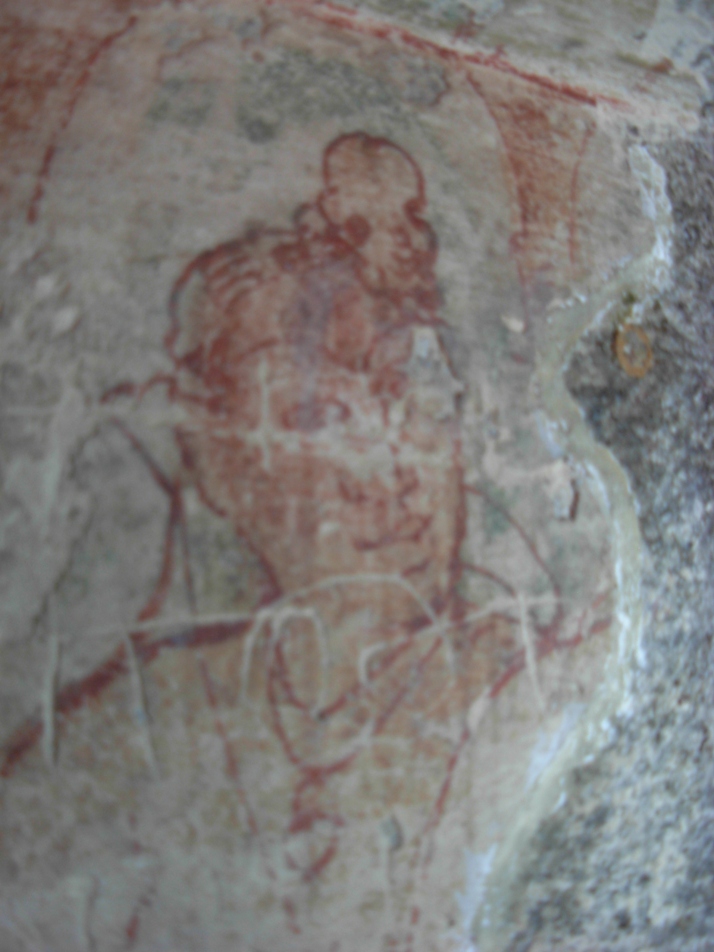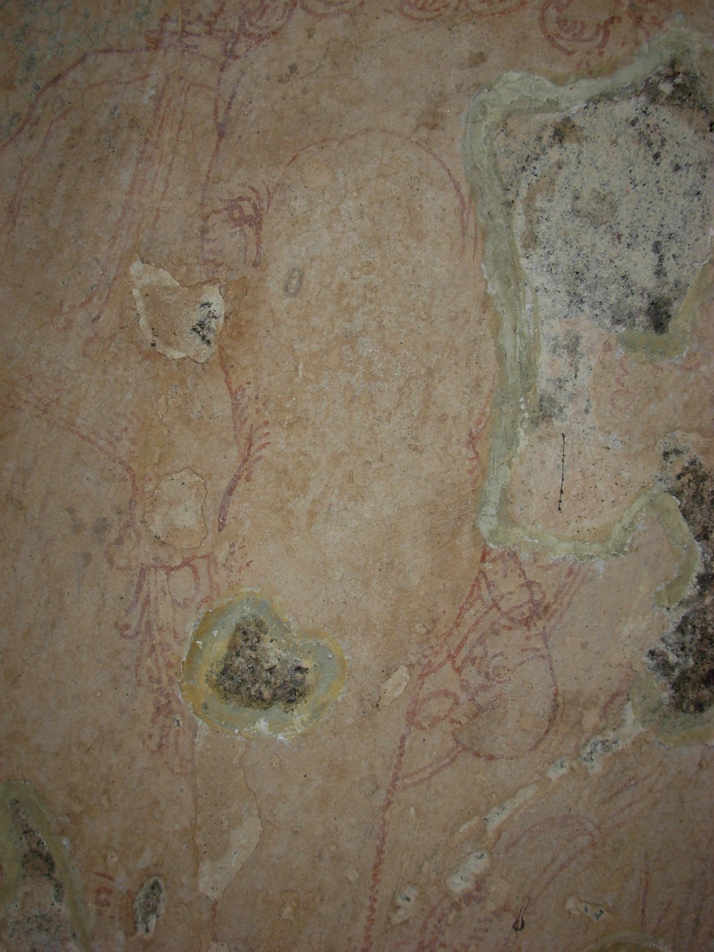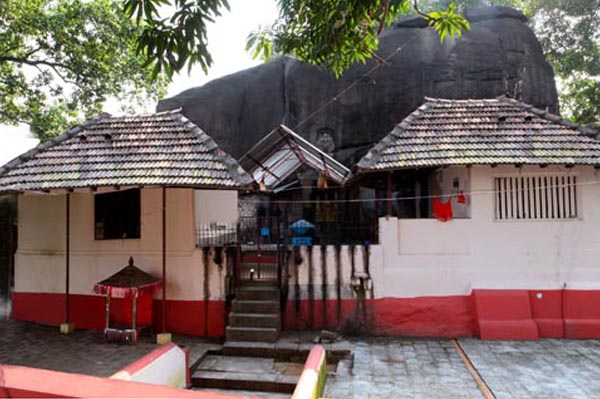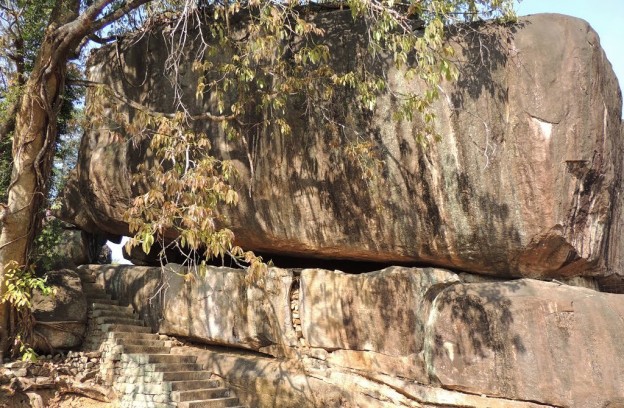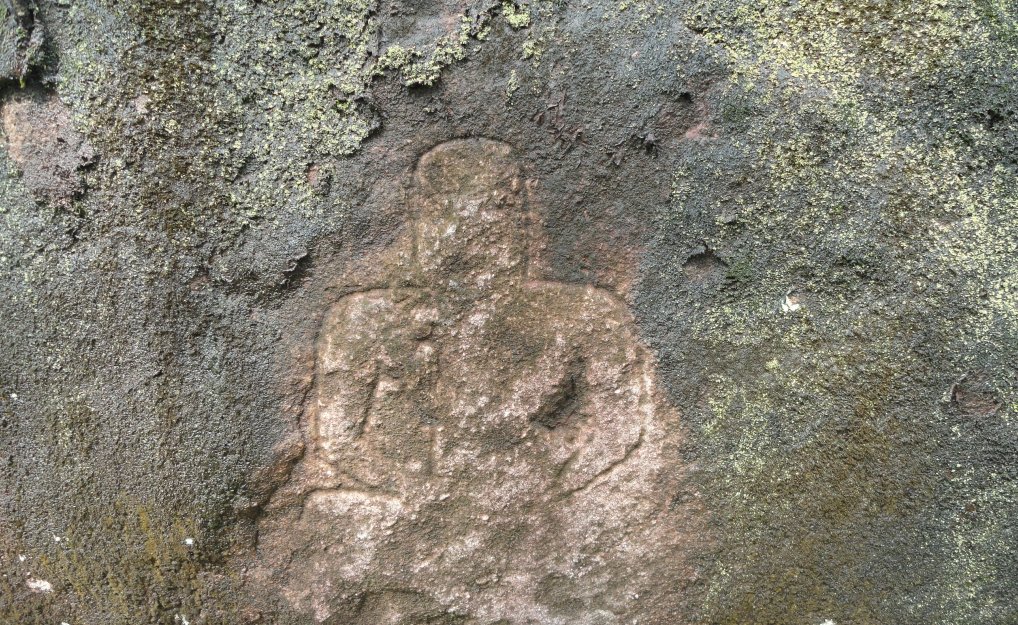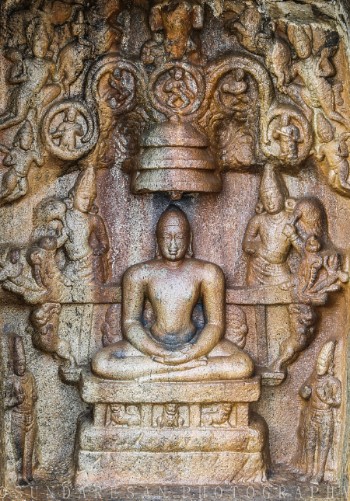 |
Picture courtesy: Bhusavalli Pandyan Yatra 2015 Kalugumalai Jain Monastery
|
Kazhugumalai Jain Monastery
Kalugumalai is an ancient Jain heritage site that has the natural cavern with rock beds where Jain ascetics observed vigorous penance and an academic center for imparting knowledge in Jain theology for 300 years during early Pandya regime. A veritable open-air gallery of diminutive sculptures of Jina or Tirthankara in three long rows, bold relief panels of Jinas - Adinatha, Parsvanatha, Mahavira, Bahubali, Ambika Yakshi and
Padmavati Yakshi. The open-air bas relief is an ensemble of over one hundred and fifty images sculpted with great skills on top of the granite rocky expanse.
The Jain ascetics, sravakas (disciple), male scholars (bhttarars) and
women scholars (kurattigal or nuns) from far off places in Tamilakam traveled to Kalugumalai and stayed
in the natural caverns and resolved to spend their lives in splendid
isolation, engaging themselves in contemplation and religious pursuits. They also taught or learned Jain theology and propagated Jainism from the 8th century A.D. Kalugumalai is a "must go place" if you like Jain heritage and architecture. The name
Kalugumalai (vultures' hill) originated quite recently i.e, about 200 years or less.
History of Jainism under Early Pandya Reign
It is important, for one who knows little about Jainism, to understand the history of Jainism under early Pandya reign to realize the intense rivalry of vedic or brahminical religion and the up-rise of the Bakthi movement and the
hostile conditions under which Jains have survived and maintained and practiced
their religion.
The 24 Tirthankaras or
Arihants or Jinas were instrumental in spreading the doctrines of Jainism. Among the 24 Tirthankaras the first 22 were mythological personages and Parswantaha the 23rd Tirthankara (877–777
B.C.) and Mahavira the 24th Tirthankara (599 –527 B.C.) were the historical personages. The Sruktakevalin
Badrabahu
(433 - 357 BC ?) and Vaisaka Munivar, the last two
pattadhars or disciples of Mahavira (totally 11
pattadhars or disciples), were instrumental in founding Jainism
in Tamil Nadu, especially in the early Pandya country. On foreseeing famine in large magnitude, Badrabahu left the Kingdom of Magada with the
Maurya King Chandragupta (340 BC - 298 BC) and the Jain followers and reached
Sravanabelagola in Mysore. Badrabahu acted as the Jain Acharya
(religious head) of the Jains. From Sravanabelagola
Badrabahu sent his disciple, Vaisaka Munivar, to the neighboring Chola
and Pandya kingdoms to spread the gospel of Jainism to the laity. It
is believed that these mendicants reached the Pandya country first as
early as the Sangam period - around 300 B.C. The Pandya rulers of the Sangam
era were tolerant and broad minded in their religious prospect and hence
all religions including Jainism prospered during their reign.
Mahavamsa,
a Buddhist text affirms that Jainism was followed in Tamil Nadu even
before the 3rd century B.C. Some other scholars believe that Jainism
entered South India well before the visit of Bhadrabahu and Chandragupta
around 6th century B.C. During 3rd century A.D. Digambara, a sect of
Jainism with nudist adherents, recognized itself from the Svetambara,
another sect with white-clad adherents. Digambara monks observed full
monastic life and the female wore white clothes and called as Aryikas.
The Mula sangh (original assembly) was the ancient assembly and monastic
order of Jain monks came from 430 A.D. and this Mula sangh was divided
into four major groups: 1. Nandi Gana (
நந்தி கணம்), 2. Sena Gana (
சேன கணம்), 3. Deva Gana (
தேவ கணம்) and 4.
Simha Gana (
சிம்ம கணம்). Every Gana had sub-sects such as Kachai (
கச்சை) and Anvayam (
அனுவயம்). The
Pallankoil copper plate (
பல்லன் கோயில் செப்பேடு) mentions about Vajra Nandi (
வஜ்ர நந்தி), the Chief Jain monk
Nandi Gana. Another Chola inscription refers about Gani
Sekara Maruporsuryan, name of Jain monk from Nandi Gana. Tirugnana
Sambandar (
திருஞான சம்மந்தர்) in one of his Tevaram hymns (
தேவாரம் பதிகம்) cites few monks such as Kanaka
Nandi, Putpa Nandi, Bhavana Nandi, Kumanama Sunaka Nandi, Kunaka Nandi
and Dhivana Nandi from Nandi Gana. Bhava Nandi is the author who
composed the Tamil Grammar work.
‘‘கனக நந்தியும் புட்ப நந்தியும் பவண நந்தியும் குமணமா
சுனக நந்தியும் குணக நந்தியும் திவண நந்தியும் மொழிகொளா
அனக நந்தியர்’’
Dramila
Sanga (
திரமிள சங்கம்) or Dravida Sanga (
திராவிட சங்கம்) branched from Nandi Gana and Vajra Nandi was
instrumental in instituting Dravida Sanga in Madurai in 470 A.D.
(Vikrama year
விக்கிரம ஆண்டு - 526).
However the splendid era of Jainism reached its
down-slope due to intense rivalry between the vedic or brahminical
religions and the up-rise of the Bhakti movement (
பக்தி இயக்கம்) in Tamilakam (
தமிழகம்) during 7th
century influenced the decline of Jainism in the 7th century A.D. Soon
Jainism recovered from the adversities and it became a religion
accommodating of the practices from brahmanical religion to withstand
religious animosity and the sectarian rancor.
Jain Iconography
Jainism and Jain iconography attached much importance to ritualistic practices and idolatry worship of Jina, Arihant, or 24 Tirthankaras. Jain iconography depicts
Tirthankara or Jina appear seated in a lotus posture on the lion throne
or standing meditative posture (kayotsarga). The Tirthankaras generally
have a triangular mole symbol (Sri-vatsa mark) on their chest, a triple
umbrella and a circular halo (radiant light drawn around the head)
above their heads and a distinctive lanchana or symbol indicated on the
pedestal. The lanchanas are listed in such texts as Tiloyapannati,
Kahavaali and Pravacanasaarodhara. Unless the conspicuous lanchana of
Tirthankara shown or his name finds mention in dedicatory inscriptions,
it is not possible to differentiate the specific Tirthankara image. Two
exceptions are there: Parsvanatha identified with five hooded serpent
and Adinatha (Rishabanatha) with lock falling on his shoulders.
The early ascetic-abodes in natural cavern (wherein
iconic and ritualistic worship of Tirthankaras and their attendant
deities received little attention till about the 6th century A.D.) lost
their prominence in the wake of Bhakti movement. Yaksha
and yakshini, or male and female Sasana-devatas or demigods or
attendant / guarding spirits, who are also the devotees the
Tirthankaras. According to Jain belief, Indra appoints one Yaksha and
one Yakshini to serve as attendants for each Tirthankara. Soon the cult of Yakhas like
Yaksharaja (Sarvahna or Sarvanubhuti) and Dharanendra Yaksha as well as Yakshis like Ambika, Chakreswari Devi, Jvalamalini, Padmavati Yakshini became popular.
Several Jaina cavern in Pandyan region including Anamalai, Alagarmalai, Aivarmalai, Chitaral, Kilakuyilkudi, Kalugumalai, Tirupparankunram,
Uttamapalayam etc could be mentioned as the best examples for such new development. Further to this Jain monks like Ajjanandi bhatarar, Gunasahara bhatara,
Kanakanandi bhatara of Kurandai, Pavanandi bhatara, Arattanemi bhatarar,
Vajranandi and few others played the predominant role in spreading
Jainism and Jain iconography and speeding up its growth. (SII, Vol. XIV, No. 102; Vol. 5,
Nos. 310, 311, 359, 380, 397 etc.).
Pandya kings like Maran
Sendan (-624 A.D.) and Arikesari Parankusa (624-674 A.D.) reposed
strong faith in Jainism and the later Pandya rulers like Srimara
Srivallabha (811-860 A.D) and Parantaka Viranaryana (866-911 A.D), lent
adequate support to Jainism and Jain iconography. The inscriptions of Parantaka Viranarayana
found at Kalugumalai as well as in Anaimalai, Arivarmalai and
Arittapatti speak about the growth of monastic establishments here.
Kalugumalai Jain Bas Relief Images
Lisa Nadine
Owen in her monograph, 'Demarcating sacred space: The Jina images at
Kalugumalai' published in International Journal of Jaina Studies. 6 (4):
2010. pp 1 -28, explored the types arrangement of approximately one hundred and fifty independent bas relief sculptures of Jinas and Jain deities on the surface of its rock formations in
Kalugumalai accompanied by individual donative inscriptions. The
rectangular or square niches present the bas relief images. The author represented five separate groups of images, based on the directional approach - the order
in which one views the bas reliefs from north-west to south-east and
not based on the chronology order i.e, from ninth or early tenth century
A.D. (chronology as viewed by the author) for further analysis and
discussion.
Group 1
From the Sastha temple you may find steps leading to the lone panel of Jina / Tirthankara. The rock face is enclosed within barbed wire fence. Lisa Owen categorizes this lone Jina / Tirthankara as Group 1. The deeply hewn niche measures about four feet in height. The Jina appear seated on lion pedestal with an elaborate throne back comprising a bolster and crossbar decorated with makara and vyla motifs at both the ends. Behind the crossbar two fly-whisk bearers come out into view; also two more ardent male followers located at the sides of throne base. The Jina is crowned by the triple umbrella (chattra). The Tirthankara is seated under the broader canopy of foliage curls. The five foliage circle motifs are arranged in a semi-circle form and the middle circle bear the figurine of dancing girl and the four other circles bear four male musicians (two of the playing long string instrument and two others beat the drum with a pair of cymbals. The ethereal figures appear on top and to the sides of Jina with hands holding the lotus flowers and offering homage. Also figurines in a panel depicting a horse rider and an emerging elephant. Date assigned by the author - ninth or early tenth century.
 |
| Group 2 Jain Image Panels |
Group 2
To the south - east of Group 1, five panels appear on a rock face just behind an Ayyanar temple. Lisa Owen assigns these panels as Group 2. The Ayyanar temple complex presents Ayyanar, Tamil village folk (prime) deity, gigantic and
colorful statues of companion deities of Ayyanar seen mounted on horses or
elephants. The Ayyanar temple, constructed about 100 years before the rock face, prevents from viewing the Group 2 and Group 3 panels. Three distinctly bold panels, striking iconographic resemblance with Group 1 panels, are arranged horizontally across the rock face. The iconographic elements include lion throne, triple umbrella, halo, tree, fly-whisk attendants, standing devotees etc. The panel at the far left strikes precise similitude with the Jina appearing in Group I panel including five foliage circles bearing the dancer, musicians, horse riders and the elephant at the center. Above these two bolder bas reliefs, a long panel bears the series of seven diminutive images of Jinas appear seated on double lotus seat (lion throne absent) and crowned by triple umbrella. The Group 2 images are accompanied with donative inscriptions.
Group 3
The panels of bas reliefs forming
Group 3, arranged on the broader rock face, are available somewhere
contiguous to Group 2 panels. The Group 3 major panels present both
kinds i.e, individual Jinas appear seated on thrones as well as Jinas /
Tirthankaras appear in series. Also there are minor panels which include
lone Tirthankara figurines with triple umbrella and double lotus seat.
 |
| Group 3 Jain Image Panels |
Parsvanatha Panel:
Parsvanatha, the twenty third Tirthankara and the
historic personage who lived in the 8
th
century B.C. He was the the son of
King Ashvasena and Queen Vamanadevi of Varanasi and was the prince of
Ikshavaku dynasty. The prince abdicated at the age of thirty and became
an ascetic. He attained kevalagnana (absolute
knowledge) and became the twenty-third
Tirthankara or
Jina. He is recognized with the blue hue and a seven hooded serpent. He appears with his Yaksha Dharaṇendra and Yakshi Padmavati.
An
interesting legend about the previous life of Parsvanatha reveals his
association with his Yaksha, Yakshi and Kamdan. The Jina in his
previous life attempted to
protect a
pair of serpents from being burnt in sacrificial fire of a brahmin. The
Jina reborn as 23rd Tirthankara and the serpents were also reborn as
Naga King
Dharanendra and Naga Queen Padmavati. The brahmin also reborn as a
demon Kamdan. Kamdan was disturbing the Jina from attaining Kevalagnana
and engaged in attacking with fire, torrential
 |
| Group 3 Parsvanatha Panel |
Bahubali (Sankrit) aka Gommatesvara (Kannada) Panel
Bahubali is an outstanding name in the Jain legends. He
was the second of the hundred sons of the first Tirthankara, Adinatha.
The warrior prince fought with his on brother Bharata for the share of
his father's kingdom.
He conquered everything from his brother and could have
become an emperor; instead he returned everything to the brother and chose
the ascetic life and proceeded to the forest to perform asceticism.
While he was in meditation for longer duration, the vines encircled all
through his body. Though he attained kavalagnana, he never prophesy
Samavasarana. Hence he is not considered as Tirthankara. The panel
depicts Bahubali covered with vine creeper all over his legs and appear
with two of his female attendants (Vidyadhari).
 |
| Group 3 Bahubali Panel |
There is an iconographic convention of pairing of Parsvanatha and Bahubali and the combination is prominent in the Jain caves at Aihole (7th century) and at Ellora (9th century) and other places including Kalugumalai.
After Group 3 panels the rock face shows a smooth bend and the huge tree with its projected branches provide shade. The panels of Groups 4 and 5 are noticed around the rock surface.
Group 4
 |
| Group 4 Jain Image Panels |
The shallow depth panels bearing the bas reliefs, forming Group 4, are sculpted on the rock face in the lower right corner and the rock formation above the panels is shaped like a canopy. The shelter appears like a natural
cavern and the same could have been modified subsequently as panels of Jina bas relifs. The panels measuring about two feet depth and the central panel presents three Tirthankaras appear seated on double lotus seat and crowned by triple umbrella. The central panel is flanked by Bahubali and Parsvanatha appear standing in separate panels. Four more Jinas appear seated on the left corner panels and the right corner panels also present seated Jinas. The bas relifs are accompanied by donative inscriptions.
Group 5
The huge rock face presents highest number of bas reliefs forming Group 5 panels are nearer to this rock face. Panoramic array of sculpted panels are located on the far right side and are arranged in three rows and depict the seated Jinas on double lotus seat or lion throne and crowned by triple umbrella. Few panels also depict tanding Jinas with the respective iconographic style. Some othe bas reliefs of Jinas situated on the far left side of the rock face appear incomplete.
 |
| Group 5 Largest Jain Panels |
 |
| Yakshi Padmavati Panel |
Two Group 5 panels are also dedicated to Yakshi Ambika and Padmavati. Padmavati is adorned with karanda makuta and appear seated on single lotus pedestal in Lalitasana posture under five serpent hoods. The yakshi holds the fruit and rosary in her lower left and right hands and the upper hands hold a goad and a snake. Her panel is taller than the panels of her attendants. Two female attendants appear with flywhisks.
 |
| Yakshi Ambika, Husband, 2 Children & Lion |
Yakshi Ambika aka Kusmandini attendant (Sasanadevi) to Tirthankara Neminatha occupies the pivotal position in Jain iconography. The cult of Ambika is popular during 7th - 12th century A.D. She appear in an exclusive panel with her husband and two children, a lion (simha) as her vehicle, and the holy tree 'kalpavriksha (areca nut tree).' 'Her husband is shown with a hand raised and his face has no detailing
so as to depict his awe and the glare from her "golden appearance"
falling on him.'
Legend of Ambika: Ambika and her two children were banished from the house by her husband Somasarman since she offered food (intended for sraddha ceremony) to the Jain monk. While her banishment they were feeling hungry and by divine intervention a mango tree and a water body came to their sight and they ate mangoes. Some miraculous events at Ambika's houehold turned her husband to justify Ambika's actions for a noble cause. Hence he decided to call his family back to his home. On seeing her husband Ambika got frightened and tried to hide herself. She died while hiding from her husband. Ambika was reborn as Sasanadevi to Neminatha Tirthankara. After the death her husband also reborn as her lion vehicle.
Kalugumalai Inscriptions (Vatteluttu)
The
Jain Monastery at Kazhugumalai has 100 Vattezhuthu (வட்டெழுத்து)
inscriptions (SII Vol V, No. 308 - SII Vol V, No. 406; Epi. Ind., Vol.
XV, f.. n. 6.) and they are inscribed below the bas reliefs as label
inscriptions.
Period:
From the available inscriptions it is
inferred by scholars that they belong to different period. They have been generally ascribed to 8th
century A.D. However K.V.Ramesh,
eminent Epigraphist and former Joint Director-General of Archaeological Survey of India (ASI) assigns them to the 10th - 11th century A.D.
Records, Messages
The prime Jaina deity at Kalugumalai Jain monastery referred to in the inscriptions as Araimalai Alvar of Tirunechuram (SII Vol.V, No. 357, 361).
There are
about one hundred and fifty sacred images (bas reliefs) were caused to
be made by the followers of Jain faith (Tamil Jains) from a number of
adjacent villages. The sacred images were caused to be made for the
merit of their parents, bhttarars, kurattigal, village elders, Pandya
officials and others.
The largest donor was Pandya King Maran Sadayan who donated 17 sacred images. Among the other donors include the artisans like carpenters, potters, smiths as well as cultivators and
others. Tirunechuram (
திருநேச்சுரம்) was also referred to as Ilanechuram (
இளநேச்சுரம்) vide an epigraph (SII,
Vol. V, No. 369) as well as Perunechuram (
பெருநேச்சுரம்) vide epigraph
(SII, Vol. V, No. 361).
The Kalugumalai monastery marked the revival of Jainism in Pandya country. Gunasahara bhattarar (
குணசாஹர பட்டாரர்) of Tirunechuram was probably the chief among the
monks looking after Jain establishments as well as endowments at
Kalugumalai (ARE 117/1894, SII, Vol. V, No. 406). His
disciples administered the academic functions and services. Inscriptions refer to the order of monks and nuns in the
Digambara Jain monasticism in Kalugumalai. An Acharya (ஆச்சாரியா) is the highest leader
of a Jain order. Upadhyaya (உபாத்யாயா) is the learned monk, who both
teaches and studies himself. Bhattara (பட்டாரா) or Bhattarar (
பட்டாரர்)
is the male disciple or
monk and Bhattari
(பட்டாரி) is the female disciple or nun (SII, Vol. V, No. 356). A Muni
(முனி) is an ordinary ascetic and Aryikas (ஆரீக) is an ordinary woman
ascetic. Women disciples referred as Manakkigal (மாணாக்கிகள்) and women
teachers as Kurattigal (கு
ரத்திகள்). Jain scholars and teachers (monks and nuns) from
far-off Jain abodes and monasteries such as Tirumalai,
(திருமலை), Tirupparuttikunram (Jina Kanchi) (திருப்பருத்திக்குன்றம்), Perumandur (பெருமாண்டூர்), and Tirunarungondai (திருநறுங்கொண்டை),
traveled to Kalugumalai to pursue and propagate Jain theology
and stayed in the natural caverns. (
SIL, Vol. V, Nos. 333, 334, 341,345, 355, 356,369, 371, 372, 373.) - Tiruchara-nattuk-kurattigal (திருச்சார நாட்டுக் குரத்திகள்) (SII, Vol. V. No. 324, 326); Nalkur
Kurattigal (நால்கூர் குரத்திகள்) (SII, Vol. V. No. 355, 356); Ilanechuram Kurattigal (இளநேச்சுரக் குரத்திகள்) (SII,
Vol. V. No. 369); Kurattigal of Tirumalai (திருமலைக் குரத்திகள்) (SII, Vol. V. No. 370);
Kurattigal of Tiruparutti(kundru) (திருப்பருத்திக்குன்றக் குரத்திகள்) (SII, Vol. V. No. 372); Milalur
kurattigal (மிழலூர்க் குரத்திகள்) (SII, Vol. V. No. 394); Kurattigal of Kudarkudi (குன்றக்குடிக் குரத்திகள்) (SII, Vol. V.
No. 396). It is believed from
the Jaina inscriptions in Kalugumalai and
others that the Jain theology classes could be coeducational and that
ocassionally
nuns served as teachers. (SII Vol. III, No.92 and SII Vol. V, No. 308 -
407). Nuns were students of male monks:
- Kurattigal (lady teachers) of Ilanechuram, disciples of Tirtha bhttara (SII, Vol. V. No. 369)
- Kurattigal of Tiruparutti (kunru - Jina Kanchi), the lady disciples of Sri Pattini bhattara (SII, Vol. V. No. 372)
Male Students studied under Woman Teachers (nuns):
- Enadi Kuttanan Satti, disciple of the Kurattigal (lady teacher) of Tirumalai (SII, Vol. V. No. 370)
Women Students under Women Teachers
- Nattigabhattarar, the (lady disciple) of Kurattigal (nun) of Nalkur (SII, Vol. V. No. 355)
- Nalkur kurattigal, the (lady disciple) of Amalanemi bhattara (lady teachers) of Nalkur (SII, Vol. V. No. 356)
- Arattan nemi kurattigal, the lady disciple of Mammiakurattigal (371)
- Milalur Kurattigal, the lady disciple of Perurkurattigal who was the
d/o Mingaikumaran of Pidangai in Karaikana nadu image (394)
The monastery was also frequented by common public from places like Alattur (அலத்தூர்), Erahur Pereyirkudi (எலகூர் பெரெயிர்க்குடி), Ilavenbai (இளவெண்பை), Kalakkudi (கலக்குடி), Karaikkudi (காரைக்குடி), Kottaru (கோட்டர்), Kurandi (குறண்டை), Nalkurkudi (நல்கூர்குடி), Pidankudi (பிடங்குடி), Tiruchcharanam etc.
Jainism condemned caste divisions and respected
all humans as equals and the monks encouraged and practiced four forms
of charity or dhana - 1.donating food to the needy (
அன்னதானம்), 2. imparting
education to all (
கல்விதானம்), 3. providing medical assistance to the poor (
மருத்துவ தானம்) and 4.
affording refuge to the helpless (
அஞ்சினான் புகலிடம்) - as their important duty. Owing to
these, Jainism flourished in ancient Tamil Nadu and the monks brought
the religion closer to the Tamil common public. The Tamil Jains
influenced and forged the religion, politics, culture and society of the
ancient Tamilagam.
Donating food for the needy: An
inscription at Kalugumalai monastery records the construction of a well
and the gift of some land for
providing some food to the ten bhattarar expounding Siddhanta, and the
Vairagiyar (monks) in the Tirumalai temple at Tirunechuram, by Siddhan
of the village at Kadantaikudi, located in Nallur-tumbur kurram. The
gift was entrusted with Gunasahara bhattara of Tirunechuram. Mentions
some more names connected with the endowment. The
Pandya king Varaguna II (Maran Sadaiyan), whose date of accession in 862
A.D. Date: 3rd regnal year (865 A.D.), is identified with this endowment (SII Vol V, No. 405).
Another inscription in the same site records
some endowment to the deity known as Tirumalaidevar at Tirunechuram by
Mahadevan, a resident of the village Perunavalur, located in Nallur -
Milalai-kurram for feeding five Vairagiyar (monks - Jaina ascetics) and
Bhatarar who expounded Siddanta (Jaina philosophy) to the laity in the
temple. The endowment was entrusted to Gunasahara bhattarar of
Tirunechuram, who was probably chief among the monks looking after Jaina
establishments at Kalugumalai (SII Vol V, No. 406)
The Jain monastery became extinct
after 13th century due to loss of Patronage after Pandya kings.
Reference (For Further Studies):
- Champakalakshmi, R. Jainism in south India, Delhi, 1974
- Desai, P.B. Jainism in South India and Some Jaina Epigraphs, Jainasamskriti
Samrakshakasamgha, Sholapur
1957.
- Ekambaranathan, A. Jaina Iconography in Tamilnadu. ed. 1. Shri Bharatvarshiya Digamber Jain (Teert Sanrakshini) Mahasabha, Lucknow. 2002
- Ekambaranathan, A. Jaina Temples of Southern Pandiyanadu.
- Ekambaranathan, A. and C.K. Sivaprakasam, Jaina Inscriptions in Tamil Nadu: : A topographical list.
Research Foundation for Jainology, Madras
1987.
464p.
Jainism under early Pandyas. In Encyclopedia of
Jainsim
http://en.encyclopediaofjainism.com/index.php?title=03.JAINISM_UNDER_THE_EARLYPANDYAS
- Ekambaranathan, A. Studies in Jainism (Tamil Nadu). Shree Sarita Jain Foundation, Chennai, 2011
- Ghosh, A. (Ed.): Jaina Arts and Architecture, New
Delhi, 1974
-
Kazhugumalai deserves universal recognition. The Hindu. August 8, 2012.
- Lisa N Owen. Demarcating Sacred Space: The Jina Images at Kalugumalai
Opulent sculptures - Epigraphist V.Vedachalam's forte is the tudy of Jaina
sites. Frontline. Vol 25, issue 21. October 11-24, 2008.
- Ravishankar Thiagarajan. Jina Images of Kazhugumalai as seen by Lisa. Site Seminar Talk on 11 Jan 2015 at "Shrinidhi", 12/1 Reserve Bank Colony MG Road, Thiruvanmiyur, Madras 41.
-
Sivaramamurti. C. Kalugumalai and Early
Pandyan Rock-cut Shrines
- Sripal, tamizakattil jainam, T. S. Madras, 1975
- South Indian Inscriptions (SII), Vol.14. Archaeological Survey of India.
- Tamil Jain by Mahima Jain The Hindu December 28,
2013 http://www.thehindu.com/features/magazine/tamil-jain/article5504164.ece
- Tamil Jain Wikipedia
http://en.wikipedia.org/wiki/Tamil_Jain.
- Vijayakumar.S. Engineering Marvel. The Hindu. June 14, 2013.
Demarcating Sacred
Space: The
Jina Images atKalugumalai (10 minutes on video)



